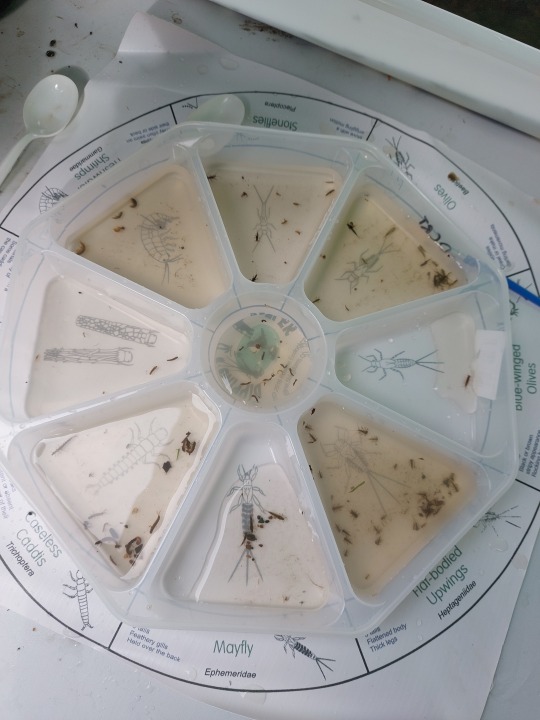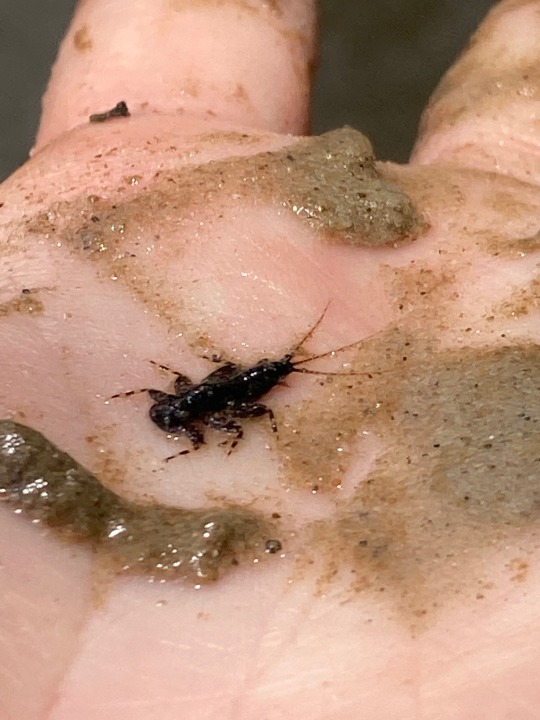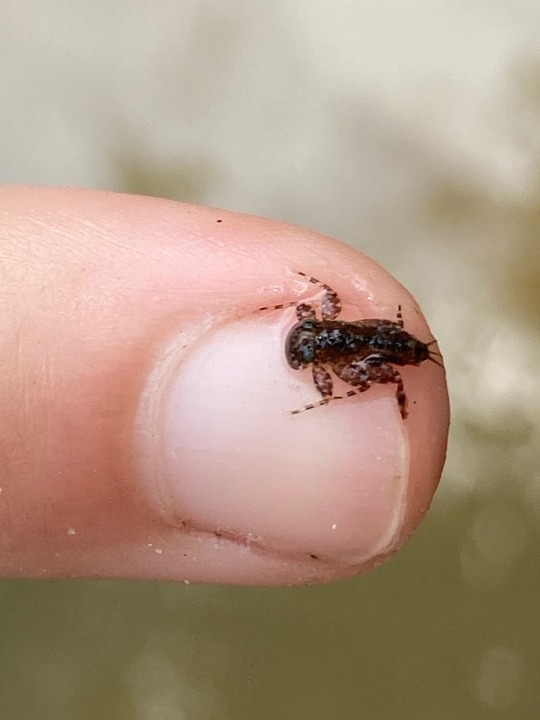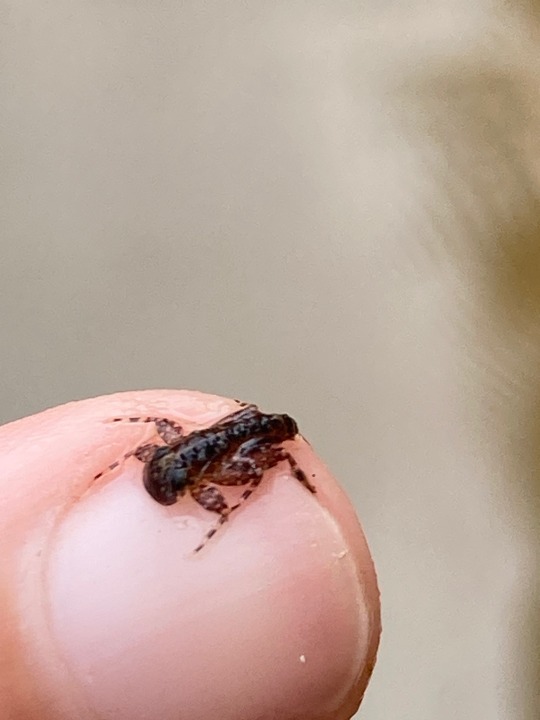#Heptageniidae
Explore tagged Tumblr posts
Text


Happy Mayfly Monday! Everyone look at these puppies! My guess is that this one’s heptageniidae larvae, the Flathead Mayfly.
You can find flathead mayflies somewhere in your vicinity! Where? Fast moving/shallow streams and lakes! Where in there? Get in the water and start checking stones and wood that’s been submerged! You’ll discover them clinging flatly to random sticks, logs, the underside of stones, roots that are sticking out the sides of a stream bank, and more! They like a wide range of substrate though, so look for them clinging to any good hard materials in that water!
Go and find the mayflies near you!
#aquatic insects#insects#entomology#bugs#nature#science#my photos#ephemeroptera#mayflies#flathead mayfly#heptageniidae#mayfly monday
44 notes
·
View notes
Text




Flatheaded Mayfly - Stenacron sp.
If the many insect species within the order Ephemeroptera were easier to identify simply by looking at pictures, I'd have many species to share here from my trips to Muskoka. Given their lifecycle, water is essential to the development of Mayflies; they inhabit water as hungry nymphs, and skim over the lakes as fleeting sub-adults and adults in search of mates. This genuinely makes cottage country a perfect location to find Mayflies and observe them. Maybe even catch a few if possible... if only to use as fish bait. In any case, when they're not flying out over the lakes, they're being drawn to cottage lights in the dead of night, allowing for some much needed close-ups of their features. What strikes me in particular about this individual is its head and eyes: the head is relatively flat, so much so that the compound eyes practically extend out of the head (akin to flattened protrusions), rather than be fully enclosed onto the head. If this sounds somewhat jumbled, I apologize. A closer look at Picture 4's head should hopefully clarify but I mean. Given these features, my photographs and a few comparisons made to other similar finds within the area, I'm of the opinion that today's find belongs to the family Heptageniidae (Flatheaded Mayflies).
This individual's features are similar to that of Mayflies sorted into the Stenacron genus, so if I were to offer up an identification, I would lean towards Stenacron interpunctatum, but this is just speculation on my part. According to Bugguide, it seems that an identification is nearly impossible unless you can get an accurate look at the Mayfly's mouthparts. However, it may interest you to know that the mandible assessment for identification only applies to the Mayfly Naiads (nymphs). Adult Mayflies meanwhile have vestigial mouthparts, and as a result, they cannot feed; all their energy is spent finding a mate near or over the water. While they do not eat, they can still intake liquids during their imago (adult) stage. Knowing this, identification has become a much greater endeavor than expected, but perhaps a revisit of this specimen using macrophotography would shed some light. Other Stenacron (and similar genera) species must be ruled out, so this cottage insect find will be labelled as "Unidentified" for now. If more conclusive information is found, this post will be updated as soon as possible with the identity of this delicate insect.
Pictures were taken on May 25, 2024 in Muskoka with a Google Pixel 4. Although Mayflies can be a splendid find over lakes as spring gives way to summer, other strange insects also emerge from the water as adults. Perhaps you may see Stoneflies, Alderflies or Fishflies?
#jonny’s insect catalogue#ontario insect#mayfly#flatheaded mayfly#heptageniidae#stenacron#stenacron specie#ephemeroptera#insect#muskoka#may2024#2024#nature#entomology#invertebrates#arthropods#photography#animals#unidentified
7 notes
·
View notes
Text
Did river invert sampling today! It was very cool, also got to see some very nice inverts other than the river ones, and maybe some planarians that aren't pictured here since I couldn't get them off the rock I saw them on

#Ecology#Rivers#Zoology#Mayfly#Stonefly#Freshwater shrimp#Caddisfly#Blackfly#Arthropoda#Insecta#Ephemeroptera#Heptageniidae#Ephemeridae#(Some of those were misidentified Baetidae‚ they got moved afterwards)#Baetidae#Ephemerellidae#Trichoptera#Rhyacophilidae#Plecoptera#Diptera#Simuliidae#Malacostraca#Amphipoda#Gammaridae#Photos#Aquatic#Not a reblog
0 notes
Note
here's some things that don't make sense:
Electric Eel - Not an eel
Mountain Goat - Not a goat
Maned Wolf - Not a wolf
King Cobra - Not a cobra
Peacock Mantis Shrimp - Not a peacock, mantis or shrimp
Horny Toad - Not a toad
Mayfly - Active through the spring and summer
Eastern Kingbird - Found in the west
what...

---
Electric Eel (Electrophorus) - Gymnotidae
Mountain Goat (Oreamnos americanus) - Bovidae
Maned Wolf (Chrysocyon brachyurus) - Canidae
King Cobra (Ophiophagus hannah) - Elapidae
Peacock Mantis Shrimp (Odontodactylus scyllarus) - Odontodactylidae
Horny Toad (Phrynosomatidae) - Phrynosoma
Mayfly (Ephemeroptera) - Heptageniidae
Eastern Kingbird (Tyrannus tyrannus) - Tyrannidae
3 notes
·
View notes
Note

Is it ok to just send cool bugs we find? If so check out this cool (I believe) Heptageniidae mayfly larva he is a BEEFY boy 💪
uhh people just do anyway. nice bug
66 notes
·
View notes
Photo

Flatheaded mayfly, Leucrocuta sp. (by me)
#Leucrocuta#Heptageniidae#Heptagenioidea#Pisciforma#Ephemeroptera#Insecta#Hexapoda#Arthropoda#mayfly#insects#bridge#summer#Riegelsville Bridge#Warren County#New Jersey#mine
18 notes
·
View notes
Photo

Camera shy #troutstreamentomology #flytying #flyfishing #dryflyfishing #mayflies #mayfly #heptageniidae #cvmayflies (at Boiling Springs, Pennsylvania)
3 notes
·
View notes
Photo

File:Rhithrogena germanica subimago on Equisetum hyemale.jpg
Deutsch: Eine weibliche Subimago (ein geflügeltes Vorimaginalstadium) der Märzbräune (Rhithrogena germanica) aus der Familie Heptageniidae. Die Subimagines besitzen eine behaarte Haut (Subimaginalhaut), die auch die Flügel überzieht. Diese sind deshalb bei den Subimagines stets etwas trüb und haben häufig, wie auch bei R. germanica, eine bestimmte Musterung. Imaginalflügel sind hingegen in aller Regel hyalin und klar durchscheinend. Die Eintagsfliegen (Ephemeroptera, auch Ephemoptera; von gr. ephemeros - eintägig, pteron - Flügel) sind die ursprünglichsten unter den Fluginsekten (Pterygota). Es gibt sie schon seit 200 Millionen Jahren. Die Eintagsfliegen bilden eine Ordnung innerhalb der Klasse der Insekten (Insecta). Von den bekannten 2.800 Arten leben in Mitteleuropa mehr als 100. Die Eintagsfliege im Bild ruht auf einem Winter-Schachtelhalm Equisetum hyemale aus der Klasse der Schachtelhalme (Equisetopsida). English: A female subimago of March Brown (Rhithrogena germanica) mayfly in the family Heptageniidae. Mayflies are insects which belong to the Order Ephemeroptera (from the Greek ephemeros, short-lived and pteron, wing, referring to the short life span of adults). They have been placed into an ancient group of insects termed the Paleoptera, which also contains the dragonflies and damselflies. They are aquatic insects whose immature stage (called naiad or, colloquially, nymph) usually lasts one year in fresh water. It is resting on a Rough Horsetail Equisetum hyemale stem. Français : Un subimago femelle de (Rhithrogena germanica) sur une fructification de Prêle. Rhithrogena germanica est une mouche de mai ou éphémère de la famille des Heptageniidés. Rhithrogena germanica est une espèce répandue en Europe, sur toutes les rivières, mais avec une prédilection pour les eaux froides et oxygénées de moyenne montagne.
Identification: Dr. Arne Haybach at www.ephemeroptera.de (thanks!)
8 January 2008
Richard Bartz, Munich aka Makro Freak Image:MFB.jpg
2 notes
·
View notes
Text



3-4-21
Day 4- For my researching fellows, what are you researching on? If you’re not currently researching, what is the topic within your field that you’re most passionate about?
AHHHHH I BEEN WAITING FOR THIS ONE, TURN IT UP!
So I do research in the parasitology lab, and despite being Pre-Dental, I adore the research I am doing. I just won an award for best undergraduate research presentation at the American Society of Parasitologists conference last fall for my work with Chordodes morgani cyst prevalence in Heptageniidae. My lab works with a lot of horsehair worms that infect snails, mayflies, crickets, beetles, etc in the midwest, and it is one helluva elusive parasite--we don't understand it's full timeline with the lifecycle, and the massive amount of things it can infect. Hoping to get published at the end of this year, and if so, we will be the first lab to nail down this worm's life cycle. It's really nerdy but I love it so much--I spend most of my time during the summer out in the field collecting samples, and during the school year I do a lot of dissection, infections, and my personal favorite, cyst counting. I'm in love with microscope work.
Can you spot any of the cysts in the pic? There are over 100 XD. If anyone is interested I made a very short tiktok of my average day to day in the lab that I can post.
#zoomester studyblr challenge#studyblr#studyspo#notes#undergrad#college#university#study#study with me#study motivation#parasitology#women in stem#microscopes#lab#science#psychology#pre-dental
22 notes
·
View notes
Text




Some friends I found while looking for crayfish in my creek! I think the first two are larval forms of mayflies or similar, then some caddisfly larvae, and some kind of spider that could dart across the surface of the water! Any idea what species these guys are?
Oh this is so fun!!! Creeks are a great place to find all kinds of bug friends. It’s often hard to determine species based on the larvae so I don’t know that I could narrow it down that far. The first one looks like a stonefly larva, likely in the family Peltoperlidae. The second a definitely a mayfly larva, probably in Heptageniidae. And you’re right on the caddisfly larvae but I couldn’t say which species based on that photo. The spider would be easier to ID with a closer, clearer photo, but maybe a juvenile six-spotted fishing spider? Sorry I couldn’t be more specific, but thank you for sharing all these super fun creek pals!
Edit - thanks for letting me know they were in NC, that was helpful!
49 notes
·
View notes
Text
My Short List of Roaring Fork Valley Tactical Fy Patterns
I am often asked which of my flies would be the most important to carry in my box while fishing the Roaring Fork Valley. While I would like to respond with “anything you see on my site will work.” After all, I have developed many new patterns that have been proven to be very productive while fishing the local area. I know that is not the answer you seek. I will do you much better than that, and be more specific, to help you make local tactical fly choices when you visit the Roaring Fork Valley.
Glam Rocker Jigs
The single most effective new fly I have in my catalog is the Glam Rocker jig. If forced into one fly pattern to compete with, I would lash on this pattern on. This fly has a lot going on for it. The Alt Rocker series covers several hatches very well from the Heptageniidae clinger shape to baetis swimmers and everything in between. Having a generic body profile allows this pattern also to cover caddis and small stoneflies. I am confident that I can go out and catch fish consistently with nothing but a box full of Alt-Rockers in various bead sizes and colors; with the top producing color being olive. In summer, when the pale morning duns and yellow sallies are hatching, the ginger brown is the best local color. The black Alt Rocker is also handy all season long, but really stands out in March when we have several large midge hatches.
MDJ jig - Mothers Day Jig
The end of April and into the first week of May is when the air fills with grannoms. Brachycentrus americanus and Brachycentrus occidentalis are the two species that hatch in overlapping waves progressing rapidly upstream. A particular point that I would like to highlight, is the fish are very sub-surface oriented during this hatch, I not bother with fishing a dry fly. I do not own a single dry fly to fish this hatch. Most feeding activity that you will see during the caddis blizzards is sub-surface on emergent pupae very near the surface, and not actually surface rises. Don’t be lured into the the false hope of stellar dry fly fishing, at least below Basalt.
When fishing the Mothers Day caddis, I fish a two fly rig set up with a Spring Caddis jig as a point with an upper dropper to drift high in the water column being a tactical Flymph.
Knuckle Dragger - Golden Stone
I like to fish big flies in big water for big fish. The Knuckle Dragger is my go-to pattern that gets deep and provokes a lot of very big river toughies. I tie the front legs extra long to active a swimming motion with fly when used in conjunction with a loop knot. The golden stone color from March through Aug. From May-July the green drake version is my choice. I tie trailer hitches on the rear of my knuckle draggers to carry a smaller less buoyant fly such as my Green Papaya Czech Nymph.
Green Papaya
Number three on my top list is the Green Papaya. There are few days that I can’t catch fish with it. This pattern is killer during the yellow sallies. I only need a size 14. I fish the Green Papaya from mid-June through September. I usually fish this as a dropper behind a Knuckle Dragger.
Black Flashback Pheasant Tail.
From mid March through early May is a good time to use this fly. It is a highly effective neo-traditional style of nymph with a down eye hook. These little gems mesmerize the trout too.
CDC Zika Jig
No time is a bad time to fish this fly, ergo it simply must be in your box. This rule applies to everyone.
I could continue, but for now, this are all absolute essentials in my personal and guide boxes.
Let me know if you have any questions or comments.
0 notes
Text





I caught too many of these babies to really count this Sunday, but my god, flat head mayflies never cease to be one of my favorite aquatic insects. Heptageniidae is an ephemeropteran I can always get behind. Caught in a sandy/silty/heavy clay river on various woody debris. Pick up your local wet logs and stare at em! You might find some!
5/5/24
39 notes
·
View notes
Text
Saying "Stenonema" makes me feel like being a three-year-old saying "cinnamon."
#entomology#Ephemeroptera#Stenonema#Heptageniidae#mayflies#text post#pointless rambling#I am physically incapable of pronouncing this genus
0 notes
Photo

These guys keep showing up at my door. #mayflies #heptageniidae #flyfishing #riseformsflyfishing #ephemeroptera #troutfood (at Boiling Springs, Pennsylvania)
1 note
·
View note
Text

Please enjoy this image I took of a heptageniidae larvae under the microscope. My favorite diagnostic characteristic for these guys is big huge anime eyes. They are like puppies to me. I caught this one March 17th, on a big chunk of floating wood in a cypressy stream. Mayflies deserve so much…
#aquatic insects#insects#bugs#entomology#science#nature#ephemeroptera#heptageniidae#flathead mayfly#my photos
13 notes
·
View notes